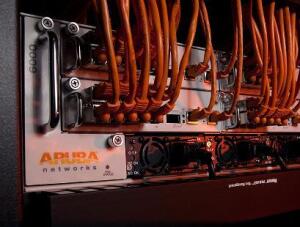Tapping In: Wi-Fi Company Aruba Networks Helps Hospitals Go Wireless
by
Kathy Mahdoubi, Senior Correspondent | June 03, 2009

Aruba Networks Wireless
LANs enable state-of-the-art
health care technologies
Hospital networks have long been operating under the preconceived notion that "the bigger the tether, the higher the performance," but new wireless network technologies have the ability to provide health care organizations more freedom at even greater speeds and in a smaller footprint than wired Ethernet networks. For this digital feature, DOTmed met up with Aruba Networks, a major provider of wireless infrastructure in the health care industry, to find out what happens when hospitals cut the cord.
There is a growing urgency within the health care informatics community to get electronic health records (EHR) online and upgraded as the Obama administration's guidelines for health IT funding begin to gel. While EHR may be driving the next generation of patient care and health care interoperability, these and other important applications fall flat without the proper network infrastructure -- a foundational technology also earmarked for federal stimulus money in the American Reinvestment and Recovery Act (ARRA).
Since 2002, Sunnyvale, CA-based Aruba Networks has deployed wireless local area networks (LANs) in hundreds of hospital systems and thousands of clinical systems across the country -- enabling such health care applications as physician and nursing staff voice communications, telemedicine solutions, vital sign monitoring systems and other biomedical applications, and yes, EHR.
"We collapse all of these systems into one, integrated network," says Manav Khurana, Head of Industry Marketing for Aruba Networks.
The air-wave of the future
Wi-Fi is just now picking up speed within the medical sphere, not because of cost issues, but because of the inadequacies of the technology's former incarnations, which had a difficult time holding up to all the critical demands of a hospital network. Ethernet networks have been the traditional choice for providing the kind of throughput necessary for the hundreds, if not thousands of users in a mid-sized to large hospital, but new trends in medical technology are pushing hospitals to commit to wireless infrastructure. In a modern, high-tech hospital, physicians enter orders and nurses make their rounds with wireless PDAs or medical-grade laptops, multi-gigabyte advanced imaging transfers are the norm, and various personnel are tapped into ubiquitous voice communications and asset management systems.
It was true until recently that wireless LANs could not compete with wired networks in terms of speed and capacity, but a new standard of wireless network -- IEEE 802.11n -- is sizing up to be Wi-Fi's ticket for success in the hospital market. Theoretically, says Khurana, IEEE 802.11n has the capacity to support speeds of 600Mbps, or six times the speed of an average Ethernet network, although day-to-day maximum speeds may not reach that high point.
